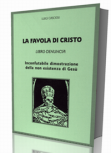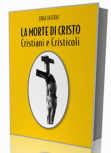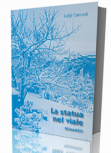12
maggio 2003
Request
of dismissing
The
request of dismissing proposed by Public Prosecutor
Doctor Renzo Petroselli is reported hereafter in its
original form.
PUBLIC
PROSECUTOR'S OFFICE
Court of Viterbo
Nr.
4998/02 R.G.N.R Persons unknown
REQUEST
OF DISMISSING
(ART. 408/411 c.p.p., 125 and 126 D.Lv. 271/89)
To
Mr. Justice for preliminary inquiries
Court of Viterbo
Public
Prosecutor Doctor Renzo PETROSELLI
Seen the acts of the penal proceedings above indicated
against PERSONS UNKNOWN:
………for the offence of which at art.661
C.P.
Committed in Viterbo on the 13th of September 2002
Registered in the register of information of offences
on the 27th of September 2002
Having
noticed that the requests for inquiries are inadmissible
both formally and for the object of ascertainment;
Having thought that the accusation is openly groundless
and that no hypothesis of offence may be verified
Seen
articles 408/411 C.P.P., 125 2 126 D-Lv. 271/89
ASKS
That Mr. Justice for preliminary inquiries in seat,
disposes the dismissal of the proceeding and orders
the subsequent restitution of the acts to this office.
Viterbo,
March 27th 2003-06-01
Public Prosecutor
Doctor Renzo PETROSELLI
(Illegible signature)
12
maggio 2003
Luigi
Cascioli's OPPOSITION to the dismissal proposed by RENZO
PETROSELLI
TO
THE PUBLIC PROSECUTOR'S OFFICE – COURT OF VITERBO
P.M. doctor PETROSELLI
PROCEEDING N. 4994/02 R:G:N:R. against PERSONS UNKNOWN
OPPOSITION TO THE DISMISSAL
The
undersigned Luigi Cascioli, residing in Roccalvecce
– via delle Province 45/B – Viterbo, referring
to himself in the third person in the exposition of
the facts,
EXPOSES
WHAT FOLLOWS
On
the 13th of September 2002, Mr Luigi Cascioli lodged
accusation/lawsuit against Don Enrico Righi (parish
priest of Bagnoregio) for the offence of which at art.
661 2 494 C.P. in so much as he himself presents Jesus
Christ as an historic figure, whilst (according to deep
philological studies and studies of textual exegesis
led by the same Mr Cascioli on the Gospels and on Patristic
literature and on historiography of the I and II century
A.D.) Jesus is not an historic figure and, moreover,
his figure has been derived from and modelled on the
pattern of such Giovanni of Gamala, as an evidence he
enclosed a copy of the parish bulletin of the Church
of S. Bonaventura of Bagnoregio.
Such deceit directed towards a multitude integrates
the abuse of popular credulity and having called Giovanni
of Gamala Jesus Christ integrates the substitution of
person of which at art. 494 C.P. and so, Mr Cascioli
asked for the punishment of the offender, reserving
for himself to bring an action against him for the indemnity
of the damage from emotional distress, he enclosed his
own book “The fable of Christ” to demonstrate
the logical presupposition ( non historicity of the
figure of Christ and substitution of the figure of Giovanni
of Gamala with that of Jesus Christ).
Subsequently, Mr Cascioli presented integrative memory,
reminding the subsistence of the aggravation of which
at art. 61 n.9 C.P. and quoting some law to support
that, enclosing moreover some supporting material.
Afterwards, the offended party asked to Mr Public Prosecutor
to proceed to probative objection, according to art.394
of the criminal rite code; the Counsel for the Prosecution
remained inert.
With an act notified on the 12th of May 2003, Mr Public
Prosecutor asked the dismissal of the proceeding (against
persons unknown) with the pseudo-motivation “that
the request of inquiry are inadmissible both formally
and for the object … that the accusation is openly
groundless and one can not verify hypothesis of offence.”
The argument of the public party is groundless and the
request of dismissal must be rejected for the following
REASONS IN FACT AND IN RIGHT
In
the request of dismissal it is established that “the
accusation is openly groundless and one can not verify
hypothesis of offence”.
To begin with one must remark the first anomaly: the
proceeding is against “persons unknown”,
while in the accusation/lawsuit the responsible of the
offence was precisely identified in the person of Don
Enrico Righi, parish priest of Bagnoregio and , besides,
the signature at the foot of the parish bulletin enclosed
to the accusation/lawsuit is his; therefore, one does
not understand why the above-named priest is not inscribed
in the register of inquired people and that one proceeded
against “persons unknown” also in presence
of a precise indication of responsibility.
Another preliminary question, which highlights the carelessness
with which Mr Cascioli's accusation gas been examined
is that the proceeding would result open only for the
offence of which at art. 661 C.P., while the accusation
is also clear and firm in maintaining the existence
of the offence of which at art. 494 C.P. (substitution
of person).
About this subject, it is incorrect to maintain, on
a logic and legal point of view, the open groundlessness
of the notitia criminis, as – if the figure of
Jesus Christ is not an historic one – the contested
offences exist in all their elements, as diffusely articulated
during the accusation and the subsequent memories, deductions
to be all understood as here recorded and transcribed.
In fact, ascribing to a third person a false name (Cass.Sez.
V 19.3 1985 n.2543) amounts to a fact-offence , so if
Don Enrico Righi ascribes to Giovanni of Gamala the
name of Jesus Christ he commits an offence in word and
the specific malice is constituted by the “aim
of getting a patrimonial or non patrimonial advantage
for himself or for other people” (Cass. Sez. V
13.4. 1981 n.3207) which, in this specific case, is
constituted by a greater number of proselytes and by
a grater yield of 8 times one thousand and greater offers
for the parish.
The two contested offences are in a formal concurrence
between themselves (Cass. Sez. V 16.10. 1998 n. 10805,
in matter of fraud and substitution of person).
Therefore, one opposes to the request of dismissal because
it is groundless.
In relation to the request of inquiries (and more precisely
of valuation to be assumed with the form of a probative
objection) the same is rejected with the crypto-motivation
that it would be inadmissible “formally and for
the object”; the measure is assumed in open violation
of Art. 125 and 394 C.P.P. as it does not explain at
all (neither in the concise forms required by decree)
which the formal inadmissibility would be and why the
object would be inadmissible.
One has to remember that Cass. Sez. Un. 21.9.2000 n.17
has established that “one has lack of motivation
not only when the justifying apparatus is missing in
a physical-textual sense, but also when the motivation
is apparent … completely incongruous when compared
to the measure that it should justify” (in conformity
to Cass.Sez. VI 1.6.1999 n.6339); in the case being
examined here it is obvious that the motivation is apparent
and so there has been violation of the law.
Therefore, one reiterates the request of probative objection,
for the following reasons.
The probative objection to be accomplished is a valuation
that aims at determining if the figure of Jesus Christ,
as diffused by the catholic faith, has a real basis
and is adherent or not to historical data.
The valuation is determinant for the existence of the
offences as, if the valuation ascertained the historic
nature of such a figure there would not be any offence,
while if the figure of Jesus Christ was a mere theological
construction without any historic verification, then
there would undoubtedly be a basic falseness that, integrated
with an opportune psychological element (that certainly
exists, as better explained in the accusation/lawsuit),
would determine the subsistence of the offences mentioned
in the above-mentioned accusation/lawsuit. Therefore,
in the case examined here the requirements provided
by art. 393 I sub-section C.P.P. are the following:
a) accomplishment of a valuation aimed at determining
the historic or fantastic nature (theological one of
Jesus Christ, which constitutes a logic prius for the
subsistence of the offences for which it is required
to proceed;
b) the evidence is to be assumed against Don Enrico
Righi
c) the evidence cannot be remitted to trial, as it would
provide a suspension superior to 60 days and so one
is in the field of application of art. 392 II sub-section
C.P.P.
The last statement is justified by the fact that the
expert would have to examine carefully all the original
and coeval sources at the time of the presumed life
of Jesus Christ and, where possible , in their original
writing language and not in translations that may betray
the primitive meaning of the words used (on possible
corruptions of meanings in the translation from one
language to another see what has been diffusely written
by the accuser in the book “The fable of Christ”
deposited in acts; besides, the expert would have to
verify (inside the primary sources) if there are or
not passages interpolated by subsequent copyists (often
of Christian faith and hence ideologically brought to
model the text according to their belief); finally,
the research of the expert will not be able to be grounded
exclusively on documentary sources, but it will have
to be extended to verify also epigraphic, material,
monumental, topographic, palaeographical, numismatical
sources and all that serves to verify the truthfulness
or not of the following statement “Jesus Christ
is not an historic character”. It appears very
clear that the inquiry is complex or long and that it
would bring to go beyond the times indicated by art.392
II sub-section C.P.P. (60 days).
It appears opportune that the valuation is entrusted
to one or more experts of history of religions and /or
roman and middle-east history referring to the period
Ist century B.C.- IInd century A.D., and also in epigraphy
and palaeography and in Hebrew, Aramaic, Greek and Latin
languages.
The offended party reserves for himself the right to
nominate a technical consultant in the field of the
requested valuation.
Maintaining that the request would be inadmissible for
a presupposed indisputability of the historic nature
of Jesus Christ is not a correct or legally sustainable
hypothesis, as a reading of the studies of the accuser
operated with a critical value, but without prejudices
or apodictic taking up of positions, determines a deep
doubt even in beliefs which are deeply rooted in the
psyche of every Italian person (Cattaneo wrote about
our impossibility of not considering ourselves catholic
) and , however, the personal beliefs of the actors
of the process (Justice, Counsel for the Prosecution
and Counsel for the Defence) must never forget that
the aim of the penal proceeding is the application of
the law and not of one's own beliefs, for which it would
be contra ius to deny the probative object required.
Therefore one asks that Mr Justice for preliminary inquiries
invites Mr Public Prosecutor to formulate the accusation
against Don Enrico Righi, parish priest of Bagnoregio,
that is to say to carry out the above-mentioned inquisition,
and also invites Mr Public Prosecutor to enlist Don
Enrico Righi in the inquired people register for having
supposedly committed the offences of which at art. 494
and 661 of the Penal Code, as these offences have been
clearly ascribed during the accusation and the subsequent
memories. That stated and considered, the undersigned
Luigi Cascioli
OPPOSES
To
the request of dismissal formulated by Mr Public Prosecutor
and notified to the same on the 12th of may 2003.
Obiediently
Luigi Cascioli
I enclose to this a copy of the request of the probative
objection and a copy of The “addition notes”
already presented with the accusation /lawsuit of the
13th of September 2002 and made of three chapters:
A) JESUS' APOSTLES (16 pages)
B) JOHN THE NAZIREUS (11 pages)
C) REPLY TO OBJECTIONS (12 pages)
Luigi Cascioli
------------
DISMISSAL
COMMENTS
There
is no need for particular explanations to demonstrate
that the dismissal required by Public Prosecutor Doctor
Renzo Petroselli takes us back to one of those medieval
trials in which the courts of the state, under menace
of the most serious retorts, had to behave according
to the will of the Holy Office.
Even though there are no more stakes and confiscation
of properties, one can understand that the means the
clergy has at its disposal to punish those who do not
show their faithfulness are however extremely effective,
from how the lawsuit instituted by Luigi Cascioli against
a priest, an exponent of a monstrous octopus, the Vatican
whose power keeps in awe even the most powerful people
on earth, is considered foolish by everyone.
Excluding that a person competent in law, and one can
suppose that a Public Prosecutor is, may have proposed
for his own belief the dismissal of the accusation/lawsuit
of Luigi Cascioli adducing so clearly deceitful reasons,
what else can one conclude but he acted according to
a pressure received from those who want to avoid a trial
causing great problems to christianity?
A) How could a justice in full possession of his faculties
ascribe an accusation/lawsuit to persons unknown when
it is addressed in the most exact and circumstantial
form to a certain don Enrico Righi, parish priest of
Bagnoregio, if he had been free from every kind of influence
or coercion?
B) How can a serious and careful justice, as a magistrate
who is engaged in respecting an ethics under oath, how
can he not realize that the subsistence of offence of
which at art.494 c.p. that refers to “substitution
of person” is clearly and firmly maintained in
the accusation?
C) How can an expert justice who has been leading a
legal activity for 30 years, maintain that the notitiae
criminis expressed in the accusation are groundless
when they subsist instead in all their clearness through
evidences drawn from documents well defined in their
historic authenticity?
D) How can a justice who has undertaken the task of
making people respect the law, how can he violate in
such an indecent way art. 125 and 394 C.P.P. declaring
that the required inquiries are inadmissible both under
a formal point of view and under the point of view of
the object, without explaining the reasons?
It is through the examination of these four errors,
which render the request of dismissal a true concentration
of illegality and abuses, that we will be able to understand
how it has not been a lay, impartial justice to decide,
but a man who acted under the influence of prejudices
to avoid the trial to the offender, a trial which involving
in the person of don Enrico Righi all the ministers
of the Chirch could represent nothing less than the
end of christianity as was clearly explained by a follower
of this religion in an e-mail addressed to his fellow
believers: “To my fellow believers: proving that
Newton has not existed does not put back into question
his equations, but saying that proving the non existence
of Christ does not put christianity back into question
is more than ever false and extremely false for the
simple reason that christianity is not a theory that
has to be confirmed or rejected by experiment, but a
teaching essentially based on the idea of the original
sin and of its ransom through the sacrifice of Jesus.
If Jesus has never existed all the Christian building
collapses. I do not believe that you will arrive at
persuading these non believers in spite of your brilliant
demonstrations of faith. Do not forget that these people
are atheists and that it is a mistake to appeal to faith
to prove the sacred. They are only permeable to reason
and if you want to do a charity action and bring them
back on the right path it is only through reason that
you can do it”. (Michel Second).
And the Church knows that, it knows it too well to allow
a process in which the non existence of Christ is demonstrated.
Let us now analyse the four questions.
A) Attribution of the accusation to persons unknown.
Question: why did one ascribe the accusation to persons
unknown when it is openly directed against a well identified
person with name, surname, address and profession?
Answer: because if one had ascribed the accusation to
a certain person, as in this case to don Enrico Righi,
the lawsuit for calumny and slander that would have
followed against Luigi Cascioli for groundlessness of
evidence, would have brought about once again a trial
that one wanted to dismiss. The dismissal, referring
to a penal proceeding against PERSONS UNKNOWN who cannot
sue, impedes every further proceeding.
B) Art. 494.
Question: why did one want to ignore art. 494 referring
to substitution of person?
Answer: because as this article involves a discussion
about an existed personage, Giovanni of Gamala, son
of Judas the Galilean organizer of the revolt of the
census, would have annihilated the intention of transforming
the historical process into an ideological one, that
ideological process to which Public Prosecutor Renzo
Petroselli certainly refers later, when he maintains
that the inquiries are inadmissible because it is impossible
to accomplish any form of inquiry on an object of divine
nature (Jesus).
In fact it is for this erroneous conviction that the
great majority of people, included those who do not
believe, maintain that it will never be possible to
demonstrate the non existence of a god whose essence
is sustained by dogmatic convictions unassailable by
reason. This has been one of the reasons for which many
of the lawyers that Luigi Cascioli consulted refused
to assist him in the trial even though they declared
themselves atheists: “One will never be able to
discuss in a penal court the existence of Jesus, because
he is a god”.
This conviction is clearly expressed in the proposal
of dismissal when it is stated, violating art.125 and
394, that the inquiries are inadmissible for the nature
of an OBJECT that ignorance and opportunism lead to
consider only in its qualification of god.
This refusal of the lawsuit for inadmissibility of the
inquiries for the nature of the object that mistakes
the figure of a Jesus god with the one of a human Jesus,
cannot be but a purposeful misunderstanding, a true
escamotage to prevent people from acknowledging truth.
Cascioli Luigi, conscious of the fact that a court will
never be able to solve diatribes between atheists and
believers which have been going on for millenniums regarding
the existence of God, if he has summoned a priest as
a representative of christianity to all intents and
purposes, he has not done that because don Enrico Righi
believes in Jesus as a theological supernatural entity
but only because the latter, maintaining the existence
of a man who has never existed in reality, draws economic
interests from an historic falseness.
Luigi Cascioli does not mind, after having ascertained
that Jesus Christ is not an historic personage, if those
who believe in him continue to consider him as the god
of eternal salvation, in the same way as no historian
is interested in Switzerland continuing to honour William
Tell as a national emblem for its independence, even
if it has been demonstrated that he has never existed.
Many are the islamic people who ask Luigi Cascioli to
start the same legal proceeding against Mohammed. From
the negative answer he gives them one can understand,
without further explanation, that the accusation/lawsuit
is not against a god but against a man: “Mohammed,
differently from Jesus, has existed in reality”.
Why does the Church avoid such a trial? Why does not
the Church, who maintains the historic existence of
Jesus, take advantage from Luigi Cascioli's accusation/lawsuit
to silence once and for all the disputes that have always
been addressed to her by hundreds of exegetes and historians?
And the answer is only this one: the Church as it built
up false documents on which the figure of Christ is
based, is the first one to be conscious of the fraud.
Did not Pope Leo X (1513-1521) declare: “We all
know too well how much profit the fable of Christ brought
to us and to our closest followers”?.
Did not Pope Paul III (1534-1549) say that Christ has
never existed?
“Paul III pushed his disrespect to the point of
stating that Jesus was no other than the sun, adored
in its Mitraic sect, and Jupiter Ammonis represented
in the paganism in the shape of a ram and of a lamb…and
he said that there was no valid document to demonstrate
the existence of Christ and that his conviction was
that Jesus had never existed”. (Mendoza, ambassador
of Spain in the Vatican).
|



